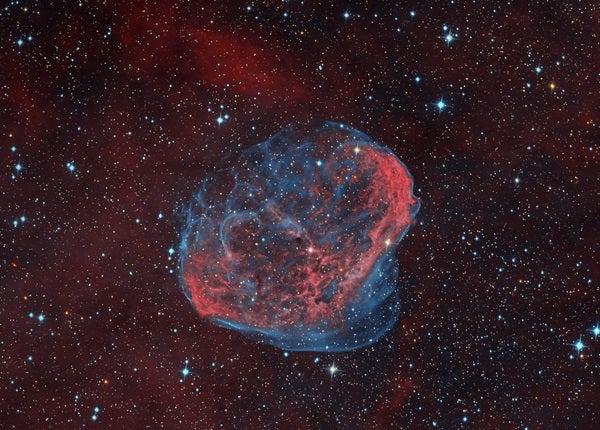The Crescent Nebula, which lies in the constellation Cygnus the Swan, has plenty of names. Among them are NGC 6888, Caldwell 27, Sharpless 2–105, and LBN 203. Whatever you call it, this object is a fascinating bubble of gas being carved out of the interstellar medium by the winds of an intensely hot star named WR 136.
As this high-velocity wind hits a slower-moving stellar wind that the star previously produced when it became a red giant, the collision produces a shock front and the shell of gas we see: NGC 6888. The interaction is so energetic, in fact, that it also produces X-rays.
The Crescent lies some 5,000 light-years away and measures about 25 light-years across. It glows at magnitude 7.4. That seems like a healthy number (just below naked-eye visibility); however, the nebula’s size (0.3° by 0.2°) really cuts down the surface brightness. You’ll begin to see some of the structure through an 8-inch telescope. But, honestly, it takes an 11-inch or larger instrument to begin to do it justice.
To find NGC 6888, point your telescope 1.2° west-northwest of the magnitude 4.8 star 34 Cygni. Or, if you want to start with a brighter star, aim 2.7° southwest of magnitude 2.2 Sadr (Gamma [γ] Cygni).
The slightly curved northwest edge is the brightest, but a short line of bright nebulosity also sits at the southwest edge. Larger telescopes will show a thick nebulous patch that runs from the westernmost edge to the central star. You’ll see WR 136 easily. It shines at 7th magnitude and lies at NGC 6888’s center.
An Oxygen-III filter really helps to bring out the contrasting sections of this object. This filter also increases its overall visibility by dimming the vast number of background stars that are part of the Milky Way running through Cygnus.
Make sure to explore Astronomy’s full list of 101 cosmic objects you must see. New entries will be added each week throughout 2022.










